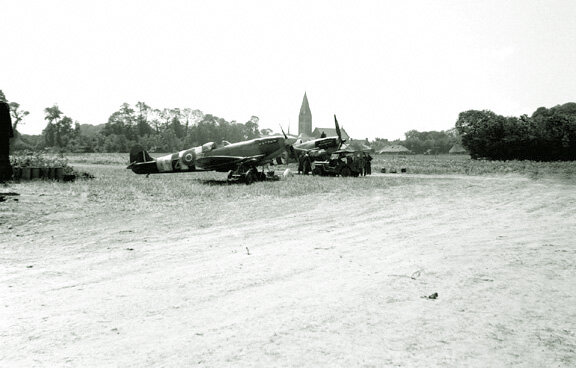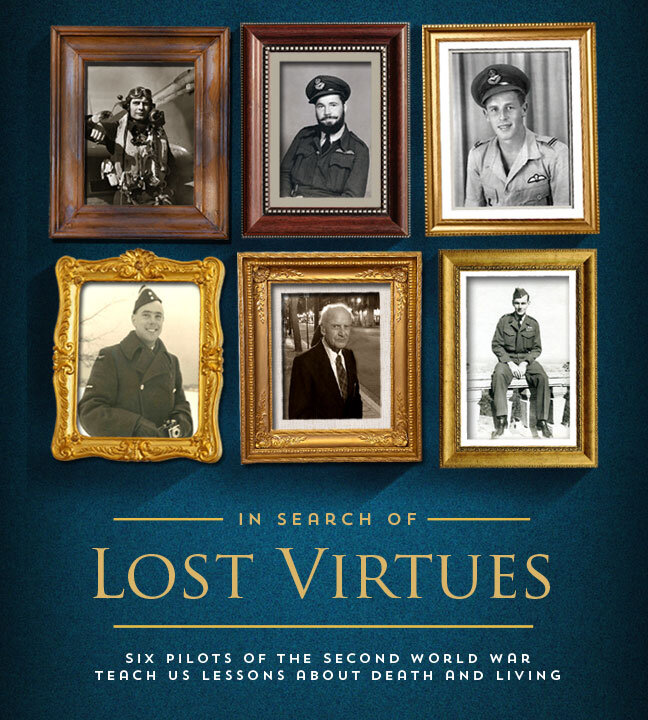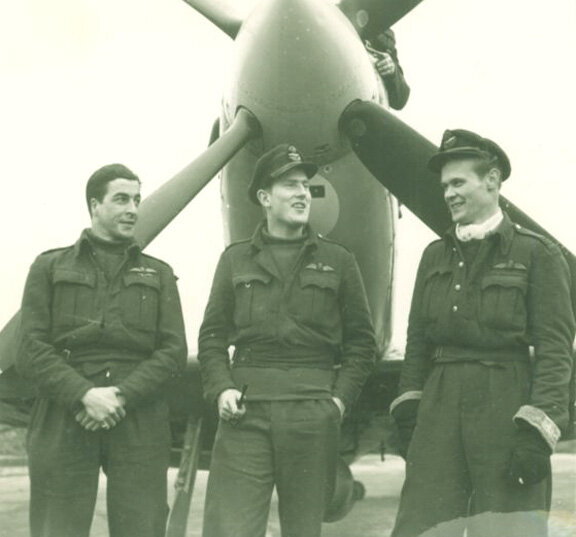ONE CRAZY SPITFIRE
n the chapter of `The Tumbling Sky’ in which he reviews the career of Wing Commander George Keefer, Hugh Halliday mentions the last kill of Keefer’s second tour, a Bf 109, on the 27th of June 1944. I was flying as Keefer’s number two on that trip, and since the circumstances of the operation were a bit unusual I thought it worthy of a story.
To check my recollection of events, and the information in my log book, I referred to the squadron Operations Reports and Monthly Summary. On June 27th we had been in France a little over a week, operating from RAF Airfield B-4 at Beny-sur-Mer, about two miles from the sea and eight from Caen. The Engineers had bulldozed the strip from a wheat field and laid pierced-steel matting to form a single runway. The matting was absolutely essential to prevent our Spitfires from bogging down when frequent rain turned the ground to mud. Unfortunately it did nothing to prevent clouds of suffocating dust from billowing up with every aircraft movement once the field dried out.
Operations fell into two categories, Armed Reconnaissance and Beachhead Patrols, the former to seek out and destroy anything found on enemy roads leading up to the front, and the latter to intercept any attempt by the Luftwaffe to attack our forces. Armed Reccos were a version of the old `sweep’, except they were flown at lower levels and had road transport rather than the Luftwaffe as the prime objective. They were normally flown at squadron strength and the range of operation could be anything from just across the lines to 150 miles behind the lines. Occasionally a 500 lb bomb would be carried to be dropped on a specific target enroute. The so-called Beachhead Patrols were initially confined to the air immediately over the landing areas but soon changed to patrols beyond the front where incoming enemy aircraft could be intercepted before reaching our lines. Initially these too were flown in squadron strength but by the 27th of June had been reduced to sections of four aircraft.
Dust infiltrated everywhere, especially up the empty cartridge ejection chutes, causing serious problems with jammed guns. The cannons seemed particularly vulnerable, frequently quitting after the first round. The armourers were trying to solve the problem by doping patches over the empty cartridge ports; the trick was to have the patch adhere to the wing long enough to get airborne but still be removed by the first empty cartridge case. I was on the afternoon shift on the 27th, and that morning while the squadron was off on an Armed Reconnaissance I flew three short test flights, two of them with my own aircraft, testing the guns after adjustments made by the armourers. We did not not have the luxury of a fixed gun butt as we would have had at a permanent station in England, but since it took only a couple of minutes flying to the German side of the line we simply flew across and tested our guns at whatever might look interesting. On the second test flight of the morning I was directed by our `Spy’, Monty Berger, to use as a target a suspected enemy mortar position, which I did. When the squadron returned they reported having attacked three road convoys, destroying 12 vehicles and damaging another 15. Three of the destroyed vehicles were troop carriers, each loaded with about 25 men.
B-4, the forward airfield at Beny-sur Mer in the heat of summer in 1944. 401 Squadron, RCAF operated from here along with other Allied fighter squadrons (412 RCAF of the same Wing is depicted) in the dust and mud. DND photo.
From one of three official reports describing the June 27 afternoon activities the following description is the most reasonable, but not completely accurate:
“The Squadron (401) was scrambled at 15.25 hrs to intercept bandits reported south of Caen. With W/Cdr Keefer leading we intercepted 12 to 15 Me.109’s north of Evreux. The Winco (sic) shot one down but the pilot baled out. F/O Hughes and F/O Ashleigh were hit by flak and forced to turn around. S/Ldr Cameron was attacked near Beauvais by several of these Jerries but by low flying and continual breaking he managed to keep from getting hit. Flak opposition through the day was quite heavy especially while straffing and the Wing suffered 12 aircraft temporarily out of action from this cause”
It was not unusual for the Wing Commander to lead our squadron, but this would normally be on a Wing operation when the W/C would bump the Squadron Leader, who would in turn bump one of the Flight Commanders. To my knowledge this was the only time the W/C would be sitting in the cockpit at the end of the runway waiting for a possible scramble, and on this occasion I would be flying as his wingman, Red 2. When the signal to scramble came we were airborne within a minute and could see the Jerries milling about low in the vicinity of Caen. When they spotted us, and having no cloud cover, they immediately turned and headed north. Caen and the area around it had probably the greatest concentration of light flak of any part of the front, but crossing it was the straightest line to an intercept. Keefer did not hesitate; at about 500’ we charged straight across Caen. Immediately Red 3 and 4 were hit by flak and returned to base.
Canadian W/C George Keefer (in helmet and F/L at the time)) was a much decorated ace of the Second World War. One “skit” for which he gained respect if not a decoration was his rescue of South African Air Force pilot John Lane from the North African desert floor. Lane had been shot down and had fired a flare to gain the attention of passing Hurricanes. Keefer saw the flare, landed and both men squeezed into the cockpit of Keefer’s Hurricane and made their get away. Here the two reenact the event for the photographer. Photo: www.acesofww2.com
Squadron Leader (at the time) George Keefer (Right) shows off a pair of German Shepherd pups with fellow Squadron Leader Ian Ormston at RAF Tangmere in the months leading up to the invasion of Normandy. Both men are wearing the distinctive blue and white diagonally striped ribbon of the Distinguished Flying Cross beneath their wings. Photo via Bill McRae
Related Stories
Click on image
401 Squadron Spitfire on European soil awaits the scramble call.
The dozen or so 109’s were now several miles ahead of us and we were flat out after them, throttle wide open. Looking back, the rest of the squadron seemed to be lagging well behind. When passing Evreux, off my right wing, there was a loud bang up front together with a heavy jolt and there followed a noticeable reduction in power. A quick check indicated everything else seemed to be normal but I began to slowly fall behind Keefer, even with my throttle still wide open. I figured my supercharger had blown. When we had almost reached the Seine at a point about 20 miles southeast of Rouen we had been chasing them for 70 miles, but the main formation was still well out of range. There was a lone straggler quite a distance behind the rest but still at least 600 yards from us; it was at this one that Keefer decided to take a `Hail Mary’ shot. To my astonishment the pilot immediately bailed out. At this point I could see Cameron, alone, well ahead of Keefer on the left; on my right there was no one, and I assumed they might be lagging behind with engine problems similar to mine. Keefer now ordered a return to base, probably figuring if we ever did catch the rest of them we would be so far from base we would not have enough fuel to get back, considering the rate at which we had been burning it.
Keefer turning and throttling back gave me a chance to catch up and stay with him for the return trip. Cameron had disappeared. After several minutes had passed he came on the radio, obviously agitated, calling desperately for help. The Jerries, realising they were now being followed by only one crazy Spitfire, had turned on him. He later told us he was right down at tree level, turning as tightly as he could, as each of them stood off and took shots at him, fortunately without success. We were by now too far away to help, even if we could find him, and Keefer ignored the calls. Eventually Cameron called to say they had given up, (probably low on fuel), and he could see them landing at a field which he believed to be Beauvais.
In the other two official reports there is no mention of Keefer and the operation is incorrectly described as `another Armed Recco’. They also state that no aircraft were destroyed by squadron aircraft. I had not thought of it before but it is logical, considering that neither the Wing Commander nor his aircraft were on squadron strength, his claim should not go to the squadron. I had always believed that the Wing score was the sum of the squadrons in it, but in fact the Wing score appears to be the sum of the squadrons less whatever the Wing Commander(s) may have scored while leading.
I found the last sentence in the official report quoted above to be amusing, “This was the first day the enemy had given any indication to fight.” I would hardly consider running away for 80 miles and not engaging until they had a minimum twelve to one advantage as fitting that description!
Although George Keefer is the subject of this story, I would be remiss not to say more about S/L Lorne Cameron. He had gone from F/O to Flight Commander to Squadron Leader within about a month at the end of 1943. He was a fearless leader who had led 401 Squadron aggressively for six months. Had the Luftwaffe not been conspicuous by its absence during this period I believe he would have joined the ranks of better known leaders. It was his aggressiveness that got him into this jam and his flying ability that got him out. I had been with him on at least two other occasions when we had pursued aircraft over similar distances, but these were single Fw190’s and we were at least four. I do not believe he would have been so rash as to continue his pursuit of an entire enemy squadron had he realized he was alone. He got away with this one but unfortunately, on July 2nd, he was shot down by intense light flak while attacking trucks during an Armed Recco. His adventures that followed, evasion, capture and escape make a fascinating story.
Squadron Leader Lorne “Boss” Cameron cuts a dashing figure standing next to his Spitfire. Photo via Bill McRae
401 Squadron commander S/L Lorne Cameron (Centre) is flanked by his two Flight Lieutenants - F/L Dick Stayner (left) B Flight and F/L (Later S/L) Jack Sheppard (Right) of A Flight. Photo taken at RAF Tangmere prior to the Normandy Invasion. Photo via Bill McRae













